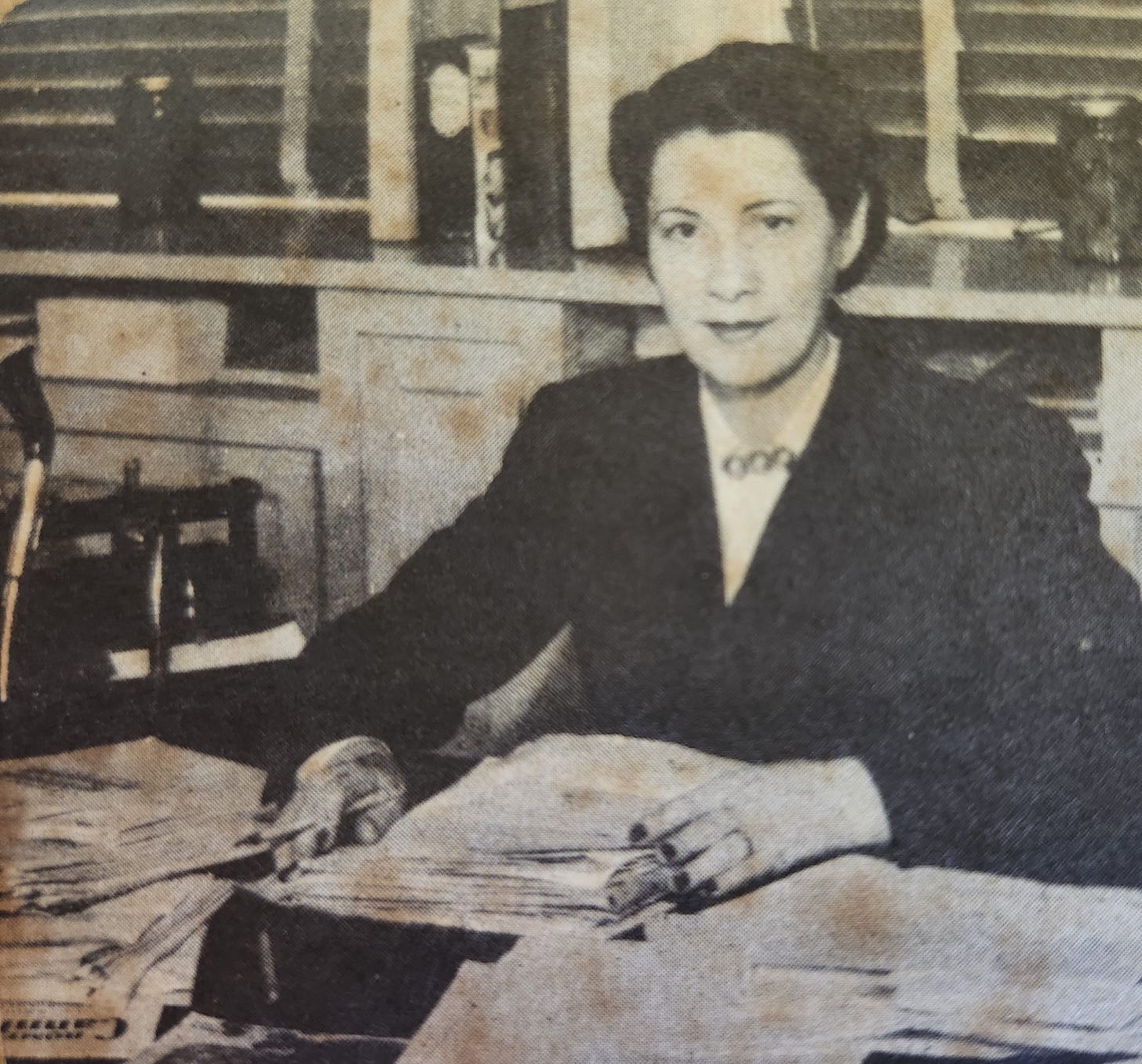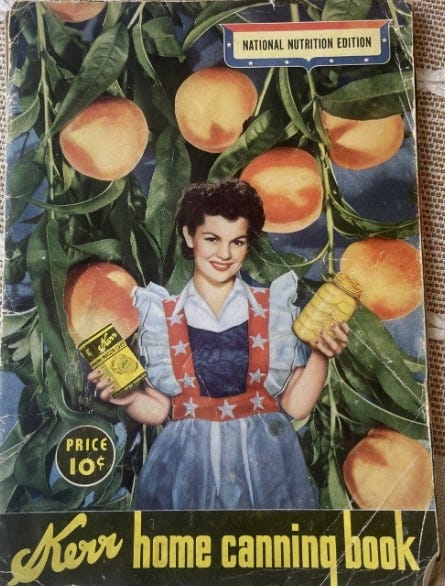ZELLA HALE WEYANT, unlike Betty Crocker, was a real woman. She lived in Sand Springs, Oklahoma, and for decades she worked as a full-time food tester and technician for Kerr Glass Manufacturing Company.
SUDDENLY, FIVE VEGANS FOR BREAKFAST and no jam. I own a stained, paperback “canning cookbook” that was my aunt’s—I inherited it, along with everything inside the farmhouse, in 1993. One day in 1994, I came across the 56-page The ABC of Canning1, by Zella Hale Weyant on a pantry shelf and opened to p. 27 for the rhubarb jam recipe; a year or so later, I referenced p. 25 for the strawberry preserves.
And then—this morning—I was faced with only a can of sort-of-pitted cherries (canners missed four) from Grocery Outlet (the awareness of pits no doubt the reason for the cheap price; alert the dentists), and five guests with limited palates. Canned cherries! Maybe that stained, torn old Kerr Glass Manufacturing canning pamphlet has some ideas.
And Just Like That! — my day took a 180—except this is no Sex and the City—this is world war and women2 “manning” the home front and reminders about sacrifice and the capitalistic genius of tying every human emotion and responsibility and fear to a corporate concept of patriotism.
From Zee3 Weyant’s introduction to The ABC of Canning:
Many centuries ago man discovered the importance of preserving food from one season to another. Food is more important today than ever before.4 Knowledge of food and its preservation is one of wartime’s very important jobs, which has been assigned to the homemaker.5 As a contribution to the National Food Program, it is her duty to make the most effective use of the products from Victory Gardens….6
Missouri-born Zee (oh! I loved her the moment I honed in on those red nails (likely Elizabeth Arden’s Victory Red) called herself a “tester” in the 1940 census, but she was far more than that—that’s a cool office for a woman in a corporation in 1940 . And second, within three years of her census status as “tester,” she was the director of the Research and Educational Department at Kerr Glass Manufacturing in Sand Springs, Oklahoma (Tulsa area), and she’d written The ABC of Canning, a major classic in basic American cuisine.7. I mean, seriously, currently culinary creatives, eat your heart out.8
Remarkably, her 56-page pamphlet was republished in September 20219. The promo notes in that new edition are thrilling—too late for Zee, who died young (in August 1966, just before her 64th birthday)—but I include them here to give us all the promise that if we produce a life work that is as meaningful this morning as it was in 82 years ago10, well, can’t ask for much more. From the 2021 edition:
This work has been selected by scholars as being culturally important and is part of the knowledge base of civilization as we know it.11
This work is in the public domain in the United States of America, and possibly other nations. Within the United States, you may freely copy and distribute this work, as no entity (individual or corporate) has a copyright on the body of the work.
Scholars believe, and we concur, that this work is important enough to be preserved, reproduced, and made generally available to the public. To ensure a quality reading experience, this work has been proofread and republished using a format that seamlessly blends the original graphical elements with text in an easy-to-read typeface.
We appreciate your support of the preservation process, and thank you for being an important part of keeping this knowledge alive and relevant.
My huzzahs to the re-publishers.
And, just to complete the job, jam long forgotten, let’s get Zee on the net in one place, even if it takes me all day long. 12
Zella “Zee” May Hale, was born August 26, 1902 in Clever, a town of about 1,200 at about 1,400 feet in the Ozark mountains of Christian County, Missouri. She was the eldest child of seven; she had five brothers, and a sister, who did not survive infancy. Of her brothers, one died in infancy; the first two were Bill and Joe and the second two, officially Lemuel and James, were called, respectively, Slick and Snooks.13 The parents were Sarah Adelie and Luther Haggard Hal. Luther died in 1948, after Addie had moved to Sand Springs to live with Zee (of course, only daughter and the eldest, and it must have worn Zee out, because Addie died at 84 less than a year before Zee herself died). Zee had married World War I veteran Charles Weyant, a mechanic in an oil factory14, when she was 19 and he was 26; they had no children. Charles outlived Zee by 20 years, dying at 90 in 1986.
I think there’s a possibility that Zella Hale Weyant was the model for this cover. She has a hint of that funny hunk of hair off-center at her hairline in the formal photo above. And how many cookbook models were there in Sand Springs, Oklahoma in the early 1940s? Jinx Faulkenberg was probably busy that day. PS Patriotic pinafore, anyone? This is the fantasy future that lulls JD Vance to sleep.
Notice that “canning” is used by a glass jar manufacturer—no one ever said “jarring” except when Elvis was on the The Ed Sullivan Show.
To be clear: I have no issues with putting food in glass jars. I have issues with putting women in glass jars.
That’s her official nickname, via relentless research.
The editor in me is screaming, scrawling WHY? Did humans survive on something else in the past? Electric shock? Space dust?
Homemakers were often parenting alone (180,000 American children were orphaned by a father in World War II), and they were often working in family businesses, on farms, in factories, telephone offices, shipyards, defense plants—working in professional jobs not open to them before—such as in my hometown, the newspaper editor , the city attorney, and the elementary school principal. But keep that garden going! Democracy depends on it. And maybe it did, who knows. No one ever complained, because 99.9% of everyone was rooting for the same team.
Excellent explanation of Victory Gardens here from the National Park Service. Quick! read it before it disappears from history and is replaced by an ad for Domino’s Pizza.
No royalties.
And then can it. See p. 41.
The republished book says the first book was published in 1945, but that is an error. Patty Feist of the marvelous but discontinued Patty’s Cooking Blog has a clearly marked 1943 edition. (I believe Patty abandoned cooking for the finer arts—very talented, but our gastronomic loss.)
The date of the first edition of what we would call a hefty pamphlet; current eBayers call a “paperback.” Kids.
This sentence alone made my damn day. An incredibly thorough, detailed, smart, respectful, kind book written by a woman for a glass factory in Oklahoma, the content alone representing far more than the 45-hour work week she reported to the 1940 U. S. Census taker.
Which it did.
Snooks, okay, there was a “Baby Snooks” radio show starring Fannie Brice…and James was the baby of the Hale family — but Slick, eh, not so sure about his major contributions.
From AI: At the now-closed Sand Springs Petrochemical Complex, once the site of oil refinery operations, including Pierce Petroleum Refinery and Sinclair Oil Corporation, which ceased operations in 1948. While the refinery operations are no longer active, the 235-acre site now hosts various industrial activities and is known as a Superfund site due to soil and groundwater contamination.






Those footnotes are hilarious--and the first two alone are worth the price of admission.